Purpose
When I moved to work in Greater Manchester in 2017, I started a journey to learn a new language, in a different culture, with thousands of people I didn’t know. And I’m not talking about ‘Mancs’, with their cool dialect, northern soul and grit. I am talking about working in the NHS. I constantly had my hand up in meetings asking what the acronyms meant. My role – to lead GM Moving, was part funded by Sport England, the Greater Manchester Combined Authority and the NHS in Greater Manchester and I was to work across, between and within these different sectors, to deliver on their collective ambitions for physical activity across the region.
Greater Manchester was at the start of its health devolution journey. Taking Charge of our Health and Social Care Strategy and the Population Health Plan had been published and our challenge was to create the conditions for the 55% of Greater Manchester residents who had said they wanted to be more active, could be supported and enabled to do so.
That’s a big job. I was one person, in a new job, with a small coalition of the willing across GM Moving partners. Where should I start? How could I work in ways that were most conducive to systemic change? Especially when I didn’t understand the language these people spoke.
This is my story of the journey of working within an integrated health and care system. Trying to find ways to embed ‘moving more’ into the culture, systems, processes, services and approach of people across the system.
The reason I am pausing now, in April 2022 to reflect and capture all this is because we are about to start the next phase of this journey. After pandemic-induced delays to the ‘launch’ of Integrated Care Systems (ICS’) across England, they will go live in July, and we will start the next chapter. Along with ICS’s across the rest of England. Each place with a different set of local conditions and contexts, but with a great deal of shared purpose and common challenges. We have a lot of learning from the past 5 years. I’m trying to capture some of my personal learning and our collective learning to support leaders across the region and perhaps around the country, as they start or continue on their own journeys to integrate health, care and physical activity.
Over the next couple of months, the GM Moving embedded researchers from Substance Consortia will be doing a ‘deep dive’ into this area of the work, to draw out evaluation and learning. This feels like the perfect time to pause, learn, review and plan our next phase for Active Lives for All, supporting Good Lives for All.
Phase 1: 2015
The GM Moving Blueprint for Change had been written in 2015, which was the beginning of the journey of the whole system approach to physical activity in the region. This journey has been captured before here. In this piece, I am trying to write through a health and care system lens, although of course a good integrated system can’t draw boundaries around these things.
By 2017 the work had moved forward some more and preparations were underway for the first mayoral elections. I came into post in early 2017, and we developed the GM Moving Strategy. This was informed by a widespread engagement and consultation with people across the region, resulting in the Taking Charge Strategy and the Population Health Plan. The conditions were set:
- Strategic leadership in place.
- The cost of inactivity to the place was understood
- There was a clear belief in the power of physical activity within the health system
- 55% of people in the region had expressed the desire to live a more active life.
- The case for change, the evidence and the will of the people were clear.
The question was what did we need to do? How could we work together across the system to bring about long-term transformational change?
The rest of this article is an attempt to explain some of the ways of working and approaches that we’ve taken so far, so we can reflect on what works and why.
The need for Disproportionate Influence
In a recent conversation with Warren Heppolette (Exec Lead for System and Strategy, GMSHSCP) he reminded us of the disproportionate influence we have managed to leverage for this agenda over the past few years and would continue to need to have.
“There are 150,000 people working in the health and care system but you don’t need to have 150,000 different conversations”
Phase 2: Exploring Approaches to Systemic Change (2018-21)
Over this period, we engaged in multiple ways of working during this time, with a test and learn approach.
There was only an emerging evidence base of how to operationalise a whole systems approach. Systems leadership learnings were emerging throughout this period, and we tried to learn as we travelled the road together. It has felt like we have been operating in the space between two worlds.
In 2018, we didn’t have the models or theories at our fingertips to help us understand what we were experiencing either. So, we explored. Iterative. Adaptive. Emergent.
We have had the opportunity to work with two evaluation teams during this period, which has helped with our understanding of what is making change happen. The first short piece of evaluation resulted in the production of the Pointers for Leadership Practice, which have guided our approach since 2018. These are helpful guide in our daily personal leadership approaches.
The second phase of evaluation has offered us embedded researchers in GM Moving, the Walking Ambition and the Local Pilot work. A realist approach, which helps to find ever-more-likely explanations of how positive change is, or isn’t, happening in a complex system .
Most recently, the team have shared Normalisation Process Theory (NPT) with us. This helps with understanding the different kinds of work that people do to implement a whole system approach. I have used the following principles of NPT as a thinking tool in this article:
- Differentiating it from existing practice- noticing what’s been different from traditional ways of working.
- Recognising my/our role in these approaches as leaders.
- Explaining how I/we have made it workable in our setting.
- Appraising what have been the benefits and risks/costs of each approach.
And I have added this one: Trying to understand what has made a difference so that we can codify and refine our ways of working for the next phase.
Reflective Practice and Data Capture
I’ve captured what we’ve been doing, how and why and the array of approaches we have taken and their characteristics. Now, with colleagues I will keep building the picture, sharing examples, reflecting on benefits and costs/risks of each. I want to capture what we have learnt as we have operationalised the strategy, to help guide us with where next.
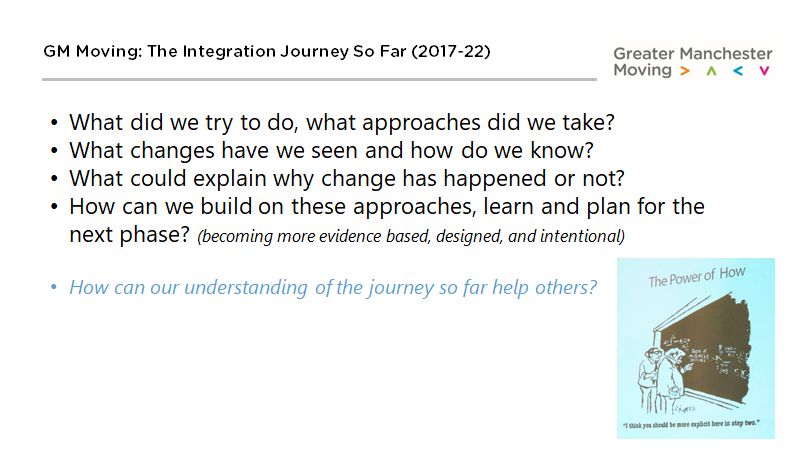
I’ve also included a section here with further useful resources, articles, links or models that might support learning. I’ll keep adding to this.
The What and the How
This blog is focussed on the ‘what’ rather than the ‘how’. I write about the how most of the time: in blogs about the principles, ways of working, approaches to leadership and relationship building which are all fundamental to this approach.
What I am asked sometimes is for more of a guide and for support in deciding what to do and where to start. So that’s what this is about. If you’re interested in the how, there are some relevant blogs linked at the end.
Approaches
The visuals below outline some of the approaches we’ve taken over the past 5 years. They are organised under the GM Moving Enablers for Change, which you can read more about here. For each approach, I have tried to explain what I mean, give some examples of this in action in the work, and explore some of the conditions, impacts, benefits and challenges in taking this approach.
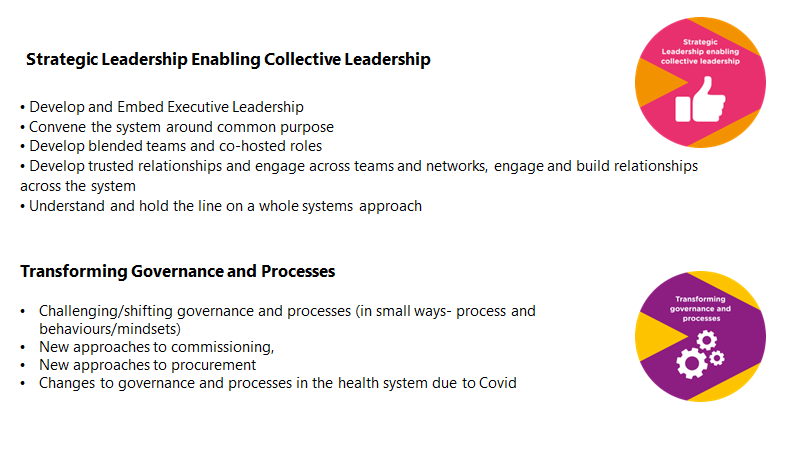
- Strategic Leadership Enabling Collective Leadership
We know that strategic leadership and collective/distributed leadership are both critical to system change on any agenda. We have developed strategic leadership and collective leadership in health over the past 5 years by building relationships and understanding between the most senior leaders in the health and care system and throughout every layer of the hierarchy.
If you don’t know where to start, look out for ‘believers’ at every level and part of the system. I would suggest that you follow a range of leaders on twitter. Notice and listen to what they talk about, notice what they care about personally and professionally.
Alongside their strategic priorities and evidence based approaches they are humans with interests, passions, families and communities. Moving will matter to them and their work somehow, so understand how. Take time to understand the things that matter most in their work too. What are the challenges they are facing? What are they working on? Moving and physical activity might be part of the solution to their most pressing issues if you take the time to listen, understand and think.
We have also found points of connection and interest from system leaders in the GM Moving ways of working– our collective approach to leadership, the enablers of change and the whole systems approach. This is often where the interest starts as people in the health system seek to transform the leadership approaches in their part of the system. We take the time to listen and talk to people and their networks about the Pointers for Leadership Practice and the Enablers for Change.
Once there is a relationship, it becomes easier to connect and ask for support. Many doors have opened to networks and parts of the system because people have become aware of GM Moving and have want to support and be a part of the movement. I share blogs on leadership, systems approaches and movement building on social media. They have generated interest and engagement from a wide range of people across the system, because the approach to reform and transformation is completely transferable. We developed a lot of relationships off the back of connections that have started on twitter.
Once the door is open, and you have arranged a coffee, a call, or to participate in a meeting with health and care leaders, what have we learnt about approaches that elicit support and action?
Often you will get a small amount of time in a meeting with health professionals. We have learnt a lot about how to use this time most effectively.
Building engagement with health professionals
- Start with a simple question: how does moving matter to you, your family/community and or your work? Give people two minutes to talk to the person next to them. This re-energises a room with a long agenda and lots of papers. It’s memorable and immediately creates a personal and professional connection to the agenda.
- Share a bit of data and evidence. Everyone need to understand the scale of the challenge of inactivity and inequalities, so make sure you have the latest data and evidence that is relevant to them.
- Explain the importance of movement and physical activity to the things that they care about or are most challenged by: mental health crisis, Covid recovery, prevention of long term conditions… understand what matters to the people you are with.
- People need to understand that it’s a complex problem that requires a whole system approach. We often use this animation to articulate this. And the GM Moving in Action 2 minute video to explain what GM Moving is, and how it’s something we can all be a part of.
- We rarely get asked for it now, but early on and for a few years, we would have to constantly hold the line on a whole systems approach and find easy ways to explain what that means in practice. People were often searching for one silver bullet to address the challenge of inactivity – often citing parkrun, or The Daily Mile as the key to a population-wide shift in behaviour. It’s important to be able to gently but firmly put the silver bullet back in it’s case and to be able to articulate the alternative, without baffling people with systems theory.
- Listen to the people in your place and use their voice to help make the case for change. For example, the community engagement that led to Taking Charge health devolution strategy showed that 55% of people in Greater Manchester wanted to move more. We were able to use that data as evidence and leverage – it showed there was an appetite for change.
- Then (don’t get stuck too long in the problem!) people want to know what they can do, and how we can support them in playing their part. I often use Appreciative Enquiry questions to help people think about what is already strong, and what would make things even better- for example I might ask how well embedded conversations about moving/physical activity are in their area, what helps, what gets in the way, and what practical steps we could take together to improve engagement, redesign systems etc. Or maybe explore how engaged they/their workforce are on this agenda, and how much influence they feel they have.
- Leaving a room/conversation with some action and next steps is vital. Conversations create change in their own right and there will be a ripple effect.. but if there are some obvious actions, make sure they are agreed and distribute the leadership/action across the system as a routine way of working.

Make sure you use (small amounts of) data, evidence and key messages to help build understanding of the agenda/challenge and why it matters. Use qualitative research, insight and personal stories to bring the data and evidence to life. Appeal to the Head, Heart and Hands in everything you do. This is vital to develop shared understanding and common purpose, once you’ve made some connections and have started to build relationships.
How do we need to approach this?
In all these approaches, it is vital work in ways that focus on relationships, build trust, develop understanding of how to influence and understanding about how mindsets matter. There will be times when we feel stuck, when there is conflict and when we need to hold our nerve. Our capabilities and skills are key to developing strategic leadership and collective leadership in the health system and beyond and it is important to develop these in our teams.
Work to embed physical activity across the whole of the health strategy, not just the Population Health Plan, Prevention Strategy or equivalent. It’s important that the agenda is embedded across strategies and that there are believers and do-ers across the system. We have needed to develop and embed executive leadership relationships. It is not enough to hold one or two senior relationships. Over time, developing a network/web of relationships into different parts of the health and care system has to be the aim. And the relationships need to be held by a range of people across the physical activity sector too, not held by one or two people or organisations. Strong relationships, built on trust and reciprocity are fundamental to an ‘anti-fragile’ collective leadership approach.
Developing blended teams and co-hosted roles is another way to hard-wire movement into the health system. It develops a sense of collective purpose and ownership of the mission, a sense of one team and shared endeavour. When people are part of multiple teams they also develop whole system understanding, which is critical to the systems approach. An example of this is my leadership role on GM Moving which is co-invested by the (now) ICS, Combined Authority and Sport England. Beth, who has led the Walking Ambition work, and now plays a system role with population health is part of the GreaterSport team, and also the ICS Population Health team. Involving people from across the system to co-invest in, and co-design, interview and appoint shared roles is another way to ensure collective ownerships and leadership.
It was important early on to develop trusted relationships across teams and networks and to establish the GM Moving Exec Group with senior health leadership engaged. The shift from GM Moving as a Steering Group (immersed in the detail of the work) to an Executive Group to provide high level leadership and direction/connection across the GM governance structures was a vital step.
Transforming Governance and Processes
Every aspect of a whole systems approach requires us to transform governance and processes. This short video explains where this enabler for change come from and what it means. These include commissioning approaches, procurement, legal systems, finance regulations and the historic and present day cultures that design, create and maintain them. I’ve written about this in the broadest sense here before. Many of these challenges are present when working on health integration.
In the context of health integration and transformation as well as in our wider work, evidence and day to day experience in the work we need courage to surface them, talk about where we are getting stuck, and work out ways to redesign systems and processes that are inhibitors of change. This is not easy. It is the area where we struggle the most.
Over the years, I have gathered insights and experiences from experienced colleagues, and we have been surfacing the issues that the embedded researchers bring back from their evaluation work in the different priority areas in GM Moving. Together we are:
- Challenging/shifting governance and processes (in small ways- process and behaviours/mindsets)
- Exploring and testing new approaches to commissioning, for example, we have a group who are working on the transforming Commissioning approaches to wellbeing services with public health colleagues across Greater Manchester.
- Testing and embedding new approaches to procurement, using Creative Dialogue and co-designing briefs with diverse perspectives and input.
- Embedding and cementing in changes to governance and processes that became possible during the pandemic.
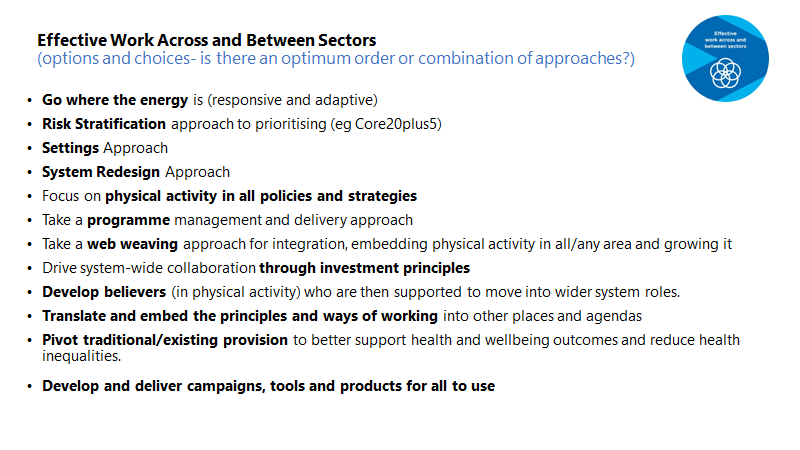
2. Effective Work Across and Between Sectors
Effective work across and between sectors is another key enabler for change, which is explained in this short video here.
GM Moving is a whole system approach, so working across sectors is a routine part of everything that is going on. There are very few examples (if any!) where one sector is working alone. Some examples of approaches people have been taking, working across sectors in a range of ways, on a range of agendas include:
Go where the energy is (responsive and adaptive) Menopause, maternity, Person and Community Centred Approaches (inc Social Prescribing), GP Excellence and Primary Care, GM Cancer, Primary Care, Nutrition and Hydration, Work and Health, Health Innovation, Dementia, Population Health, School Readiness, Allied Health Professionals etc etc..
Take a Risk Stratification approach to prioritising: Cancer, CVD, Respiratory, Covid-19.
Take a Settings Approach: Active Practices, Active Hospitals, Active Workplaces, Active Pharmacies
Take a System Redesign Approach: redesigning services with movement and physical activity designed in. This could be around a specific service area such as maternity services, menopause support services.
A focus on physical activity in all policies and strategies: for example through mapping GM policies to identify which have physical activity embedded in them. Once policy and strategy gaps have been identified, we can target those that don’t feature physical activity, with a focus on those that can make the most difference.
Taking a programme management and delivery approach: such as the GM Active Prehab for Cancer Programme, the GM Walking Ambition which is currently focussed on connecting with health and care systems.
Taking a web weaving approach for integration, embedding physical activity in all areas, going where there is energy, opportunities, open doors, need or demand, due to national or local contexts and drivers. This might include: Ageing Well, Falls Prevention, Mental Health and Wellbeing, Social Prescribing, Prehab/Rehab and services supporting those with long term conditions leads.
Drive system-wide collaboration through investment principles. This approach is more and more common, for example the Sport England funded Local Pilot, the GM Walking Grants (driving collaboration between voluntary sector and health sector organisations).
Develop the skills and capabilities of your teams, so that they can be most effective as system leaders. Support and develop them to move into wider system leadership roles with influence across agendas and organisations. This talent development or talent incubation of physical activity ‘believers’ is a good way to spread and grow ‘belief’ in this agenda right across the system.
Translate and embed the principles and ways of working into other places and agendas. The principles of public service reform helped to shape the principles within GM Moving. These principles have been developed into ways of working and Pointers for Leadership Practice have shaped the behaviours of leaders across the system. This is fundamental to the success of this work.
Pivot traditional/existing provision to better support health and wellbeing outcomes and reduce health inequalities. An example of this is the Pivot to Wellbeing of community leisure services in Greater Manchester.
Develop and deliver campaigns, tools and products for all to use eg That Counts, Keep Moving, Keep GM Moving, Public Narrative guides, Keeping Well at Home, Daily Mile Toolkit.
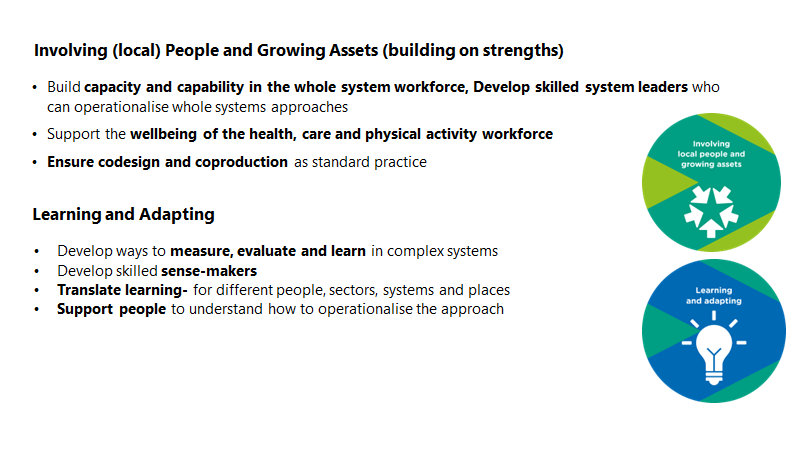
3. Involving People and Growing Assets (building on strengths)
This enabler for change is explained in the short video here and is another key one when working on health integration. The main thing here is to involve people and build on strengths that they have, the contribution that their organisation or team can make to the work, and that people work together, co-designing services and solutions based on data, evidence and insight. The GM Prehab for Cancer is a great example of this where everyone on the team brings their strengths and the skills, knowledge, capabilities and capacity of their organisation or team. Seeing others as equal partners without hierarchy and building on the assets is key.
This blog is in draft form- the sections below are still in development.
Some approaches we can take are set out below.
- Build capacity and capability in the whole system workforce, Develop skilled system leaders who can operationalise whole systems approaches.
- Support the wellbeing of the health, care and physical activity workforce.
- Ensure codesign and coproduction as standard practice (everything!)
4. Learning and Adapting
- Develop ways to measure, evaluate and learn in complex systems (new forms of evaluation (realist, revaluation), systematising approaches, growing capability to become embedded researchers in the work.
- Develop skilled sense-makers (designing in, action learning, capability building)
- Translate learning- for different people, sectors, systems and places (multiple approaches and activities)
- Support people to understand how to operationalise the approach (workshops, communities of practice and learning, how-to-guides, The Power of How, blogs, videos, animations…..etc)
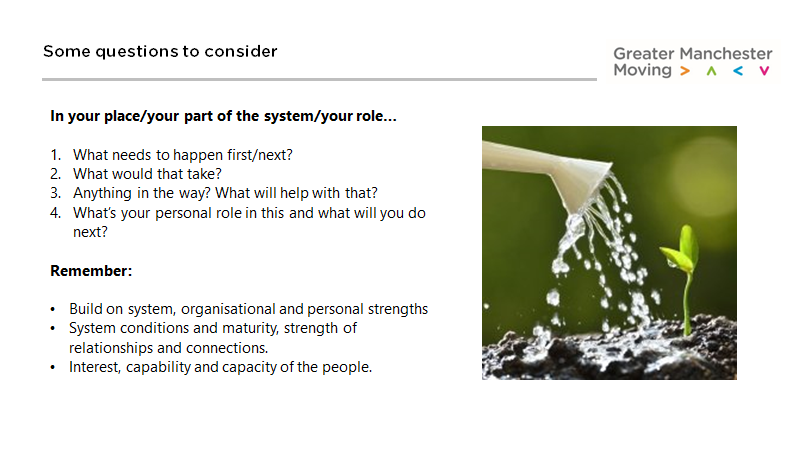
National – Regional – Local – Neighbourhood: What to do at each spatial level?
Another important question to bear in mind when planning our approaches to integration, is “what is best to happen at which spatial level?”. Those of us working at national, regional and locality levels are here to create the conditions for health equality in neighbourhoods. This is the spatial level that most people live their lives at. Learning about what is worth doing the same way across England or Greater Manchester is key. Then, there are ten localities in GM and 240 neighbourhoods. Each is unique, but there are also things that they all need, which can be supported at scale.
If we work by the principle of ‘locally led, GM supported, nationally enabled” it raises some specific questions:
- What can be done differently at a national level that creates better conditions for EVERYONE working locally?
- What makes sense to do the same way across the whole of GM or the whole of a Borough?
- What is so unique that it has to happen differently in a neighbourhood? (and how do we ensure the learning from this is drawn back out to support others?)
We have been testing and learning in our neighbourhood, locality, GM level work for some time and have some evidence about what is needed. This is for another blog, but I will finish this by saying that no matter which spatial level you are working at, the approaches described above are translatable to your place and your work. Please test them and use them.
Where Next for Greater Manchester?
Phase 3 (2022-5)
Last year we refreshed the GM Moving Strategy, launching GM Moving in Action in September 2021. One of the Commitments is Integrated Health and Care. During and following the launch of the strategy, there was a process of system-wide engagement to develop a deep understanding of progress and set priorities for the next phase, ready for the launch of the ICS. We have a bigger coalition of the willing now, and a set of local and national conditions that should better support transformational change. And we know that physical activity has a role to play on every agenda and in every place.
Now, we need to be clear, effective and impactful in our ways of working, drawing on the learning so far and ensuring collective and distributed leadership for change. Which is I did the exercise above and why we are now conducting an immersive piece of evaluation into the physical activity and health integration work with our embedded research team.
The next phase of core co-investment from the ICS is for GM layer leaders to play a systemic role, building on what we have learnt. A set of priorities and deliverables have been agreed for a transition year (2022-3). During this year we will continue to learn, adapt and plan for the next phase. Together we will:
- Continue to operationalise the whole systems approach.
- Seek to ‘codify’ the ways of working that best effect change.
- Develop further clarity about where to lead, support and connect the system.
- Focus on how we can create the conditions for ‘disproportionate influence’ across the system.
- Keep learning how to measure, evaluate and learn in a systems approach.
What kind of leadership does this take?
At the beginning of this article, I mentioned the Pointers for Leadership Practice. The importance of these can’t be overstated. They are fundamental to operationalising a whole system approach. They were developed in 2018, and are standing the test of time well. Use them, share them and notice the difference!
Useful Reading
For more information on GM Moving Health Integrations Priority, stay up to date @GmMoving and on the website here.
Sorry I didnât look at it when you sent it .
Iâve had no internet connection for 3 days ;( â¹
Have a great Easter
S
Sam Keighley
Strategic Director
T: 0330 2020 280 (Ext 139) | M: 07794 247873
W: yorkshiresport.org | Nepshaw Lane South, Morley LS27 7JQ
This email was sent at a time that was convenient for me. Please donât feel you need to respond outside of your working hours.
[Generic_Nov 2019]
LikeLike